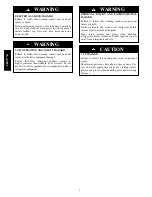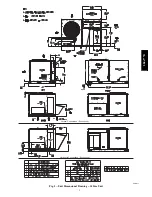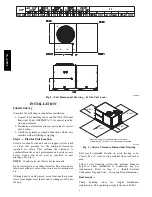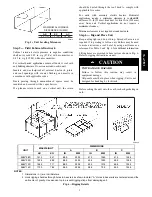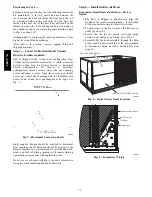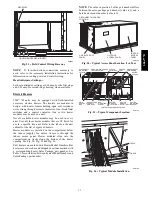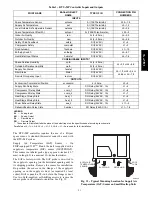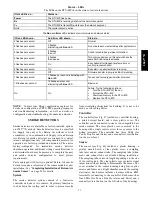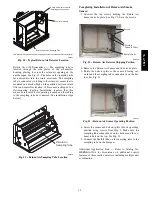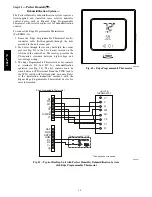
16
LOW VOLTAGE
CONDUIT
CONNECTOR
HIGH VOLTAGE
CONDUIT
CONNECTOR
C08637
Fig. 21 -- Thru--Base Connection Fittings
Check tightness of connector lock nuts before connecting
electrical conduits.
Field--supplied and field--installed liquidtight conduit
connectors and conduit may be attached to the connectors
on the basepan. Pull correctly rated high voltage and low
voltage through appropriate conduits. Connect the power
conduit to the internal disconnect (if unit is so equipped)
or to the external disconnect (through unit side panel). A
hole must be field cut in the main control box bottom on
the left side so the 24--v control connections can be made.
Connect the control power conduit to the unit control box
at this hole.
Units without Thru--Base Connections —
1. Install power wiring conduit through side panel open-
ings. Install conduit between disconnect and control
box.
2. Install power lines to terminal connections as shown
in Fig. 17.
All Units —
Voltage to compressor terminals during operation must be
within voltage range indicated on unit nameplate. See
Table 5. On 3--phase units, voltages between phases must
be balanced within 2% and the current within 10%. Use
the formula shown in the legend for Table 5, Note 2 (see
page 39) to determine the percent of voltage imbalance.
Operation on improper line voltage or excessive phase
imbalance constitutes abuse and may cause damage to
electrical components. Such operation would invalidate
any applicable Bryant warranty.
Field Control Wiring —
The 558J***D unit requires an external temperature
control device. This device can be a thermostat emulation
device provided as part of a third--party Building
Management System.
Thermostat —
Install a Bryant--approved accessory thermostat according
to installation instructions included with the accessory.
For complete economizer function, select a two--stage
cooling thermostat. Locate the thermostat accessory on a
solid wall in the conditioned space to sense average
temperature in accordance with the thermostat installation
instructions.
If the thermostat contains a logic circuit requiring 24--v
power, use a thermostat cable or equivalent single leads of
different colors with minimum of seven leads. If the
thermostat does not require a 24--v source (no “C”
connection required), use a thermostat cable or equivalent
with minimum of six leads. Check the thermostat
installation instructions for additional features which
might require additional conductors in the cable.
For wire runs up to 50 ft. (15 m), use no. 18 AWG
(American Wire Gage) insulated wire (35
_
C minimum).
For 50 to 75 ft. (15 to 23 m), use no. 16 AWG insulated
wire (35
_
C minimum). For over 75 ft. (23 m), use no. 14
AWG insulated wire (35
_
C minimum). All wire sizes
larger than no. 18 AWG cannot be directly connected to
the thermostat and will require a junction box and splice
at the thermostat.
Unit without thru--base connection kit —
Pass the thermostat control wires through the hole
provided in the end panel (see item “D” in the view
labeled “LEFT” in Fig. 1 & 2); then feed the wires
through the raceway built into the corner post to the
control box. Pull the wires over to the terminal strip on the
upper--left corner of the Central Ternimal Board (CTB).
See Fig. 22.
Typical
Thermostat
Connections
Central
Terminal
Board
W1
Y2
Y1
R
W2
G
C
X
W1
Y2
Y1
R
W2
G
C
X
T–STAT
C
W2
G
W1
O/B/Y2
R
Y1
(Note 1)
Note 1: Typical multi-function marking. Follow manufacturer’s configuration
instructions to select Y2.
Note 2: W2 connection not required on units with single-stage heating.
Field Wiring
(Note 2)
C09351
Fig. 22 -- Typical Low--Voltage Control Connections
558J
***D

